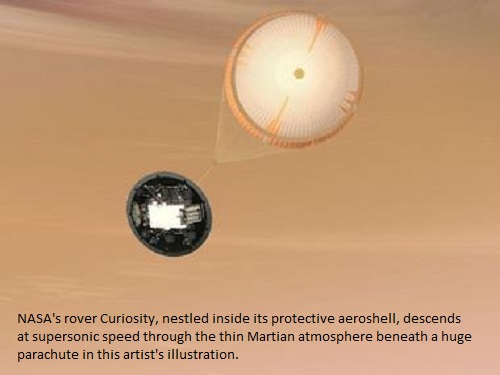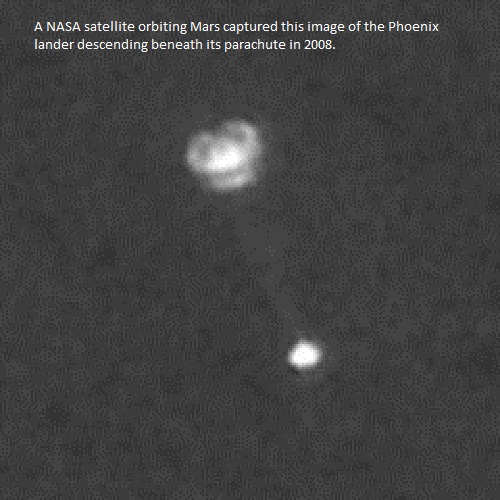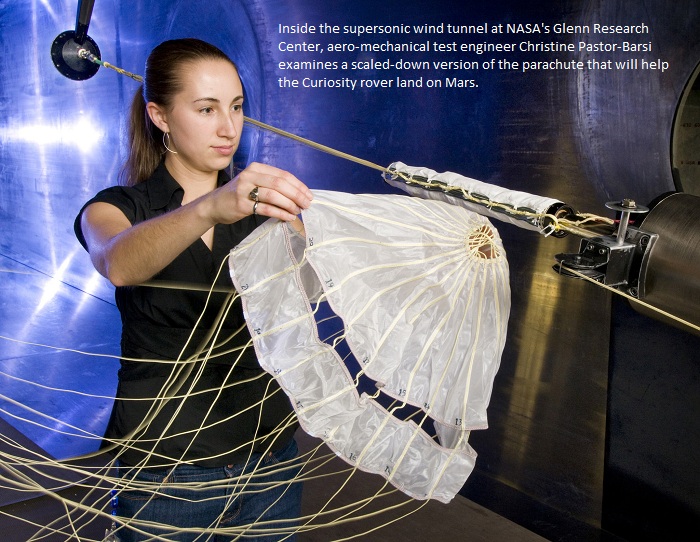Wind tunnel testing at Cleveland's NASA Glenn Research Center boosts confidence in Curiosity rover's Mars parachute
-

-
As the Mars rover Curiosityscreams from space down to the Red Planet's surface next Sunday night, it will endure more aerobatic twists than a Cirque du Soleil trapeze artist.
First it will blaze through the upper atmosphere like a fireball, then it will be slowed by a supersonic parachute, and finally it will dangle from a rocket-powered "sky crane" before gently touching down on the rusty Martian soil.
NASA calls the complicated, harrowing descent "seven minutes of terror." The outcome of two of those minutes, during which the rover will hang below the biggest parachute ever deployed on Mars while falling at hundreds of miles an hour, hinges in part on testing done at Cleveland's Glenn Research Center.
The three months of wind tunnel trials here in 2008 helped convince NASA Jet Propulsion Laboratory engineers overseeing the mission that the chute and its $1.8 billion passenger could safely withstand a scary-looking aerodynamic quirk called "area oscillation."
The phenomenon, captured by high-speed cameras during the Glenn tests, repeatedly causes the canopy to partially collapse, then re-inflate, in the supersonic slipstream, billowing like the folds of a sea creature.
"The way the parachute was oscillating was kind of like a squid or an octopus," said Christine Pastor-Barsi, an aero-mechanical test engineer with Glenn contractor Sierra-Lobo Inc. who participated in the testing. "It was really cool looking, actually."
Maybe. But it would be extremely uncool if a chute failure ended the ambitious Mars Science Laboratory mission before the rover was even on the ground.
"We have an almost unprecedented level of confidence that this [landing] is going to work," said JPL aerospace engineer Devin Kipp, who's in charge of the parachute portion of Curiosity's descent. "But at the same time, this is the most complex thing we've ever attempted" on Mars, "and it has the most number of wild-card, random variables that could go wrong."
So NASA engineers pored over every aspect of what's called EDL, or entry, descent and landing.
The space agency's three previous Mars rovers – Sojourner, in 1997, and the twins Spirit and Opporunity, in 2004 – used a sequence of heat shield, parachute, retro rockets and a protective cocoon of airbags to slow their plummet through the planet's thin atmosphere and cushion their bouncing arrival.
But at nearly a ton, the Mini Cooper-sized Curiosity is five times heavier than either Spirit or Opportunity, and a whopping 86 times the mass of tiny Sojurner, which was no bigger than an adult beagle. The tried-and-true airbags –bounce-tested years ago on simulated Martian rocks inside the giant vacuum chamber at NASA's Plum Brook Station near Sandusky – couldn't handle Curiosity's bulk.
So NASA ditched the airbags in favor of the "sky crane." It's a sort of jet pack on steroids that will hover while gently lowering Curiosity to the ground on a tether, then fly a safe distance away and crash. The sky crane not only can handle heavy-lifting, but it provides a far more precise landing spot than the careening air bags. "It looks crazy, but it's well-reasoned," Kipp said.
For the maneuver to work, though, Curiosity's initial descent still has to be slowed by a heat shield, and the supersonic parachute.
Fortunately, a lot of what NASA needed to know about parachute behavior in the wispy Martian atmosphere had already been worked out in preparation for the Viking Mars lander missions in 1976. There were well-documented chute inflation tests in Earth's thin stratosphere, and drop tests with dummy loads. Having those results saved the Curiosity team months of work and millions of dollars in costs.
But there were still differences, and some unknowns, that could affect performance and had to be checked out.
Curiosity's chute would have to be bigger than Viking's – 70 feet across, compared to 53 – to handle the rover's additional weight and its bullet-fast, supersonic 900 mph speed when the canopy unfurls. Its fabric is nylon, not Viking's disco-era polyester, and its suspension cords substitute Kevlar for Viking's more stretchy Dacron.
The engineers needed to know that Curiosity's canopy material wouldn't suffer damaging friction burns when it burst from its packing bag during deployment. (It didn't.)
And they needed to get to the bottom of some odd flight data readings that had showed up just seconds after NASA's Phoenix Mars lander opened its Viking-style parachute, en route to a successful 2008 landing near Mars' north polar ice cap.
The readings seemed to indicate the Phoenix chute was undergoing the jellyfish-like undulations of area oscillation, partially deflating and refilling, over and over. "There was a lot of concern that this is a phenomenon we [didn't] have a good physical understanding of," said Kipp.
Since Curiosity's chute would be 33 percent larger than the Viking and Phoenix canopies, "we had to convince ourselves that, by making it bigger, we weren't introducing any new physics that Viking [and Phoenix] didn't have to deal with," Kipp said.
-

-
To tackle the problem, JPL and Stanford University engineers used data from the 1970s Viking parachute tests to program a computer model that could predict how Curiosity's canopy would behave. The JPL Curiosity team also commissioned the chute tests at Glenn's supersonic wind tunnel, which could mimic the punishing conditions of the rover's Mars descent.
At 10 feet tall, 10 feet wide and 48 feet long, the Glenn facility is the largest supersonic wind tunnel in the country. Built in the early 1950s, and still operating with its original compressors and drive motors, the "10 by 10" can whip up a gale that dwarfs the worst hurricane on record.
CLEVELAND, Ohio — Its Mach 3.5 top speed (3.5 times the speed of sound, or 2,664 mph) is so powerful that grains of dirt become damaging projectiles, requiring that the tunnel be kept scrupulously clean. Over the years, the 10 by 10 has tested scaled-down models or components of everything from the SR-71 Blackbird spy plane and the space shuttle to the Saturn moon rocket.
The Curiosity chute tests at Glenn were only meant to study chute motion, not durability, and their Mach 2-2.5 wind speeds were considerably higher than what the rover's canopy will experience at Mars. So the scaled-down 2-feet-wide mini-chutes lasted only a couple of seconds in the howling tunnel before ripping apart.
But in that blink of an eye, ultra-fast specialized cameras helped the engineers see what was going on. Optical tricks allowed them to visualize two supersonic shock waves, one created by air striking the chute, and the other building up around Curiosity's protective capsule.
In video footage from one of the tests, the chute's shock wave looks like a writhing alien blob, spilling out from under the canopy and snaking along its cords as if alive. "It was kind of crawling up those suspension lines," said Glenn mechanical engineer Jim Roeder, who led the wind tunnel tests.
In certain supersonic conditions, those two separate "bow shocks" can mingle in the space between capsule and chute, causing turbulence that makes the canopy repeatedly sag, then recover.
Creating more distance between canopy and capsule by lengthening the chute's cords could alter the shock wave patterns and ease the area oscillations. "Right now, the suspension lines are 50 meters long," Kipp said. "If we made them 80 or 100 meters, this problem would start to go away."
But longer cords would be heavier and bulkier, eating up precious room and fuel on the spacecraft delivering Curiosity to Mars. The Glenn wind tunnel tests helped convince the JPL team that the oscillations wouldn't fully collapse Curiosity's chute. And hundreds of thousands of computer simulations showed that the chute's billowing during descent barely affected the rover's carefully planned trajectory down to the surface.
"We felt like we had tested and analyzed ourselves out of being concerned about this problem," Kipp said.
The NASA engineers won't know whether that confidence is justified until early on the morning of August 6, when they'll listen and hope for Curiosity's report that it has safely touched down. The parachute is just one of many components that must work for the rover to survive. "Entry, descent and landing is like a game of dominoes," NASA's Mars Exploration Program director Doug McCuistion said in a recent news briefing. "If one of them is out of place, it's very likely that the last domino won't fall."
The "seven minutes of terror" landing sequence is automated, so all everyone can do at that point is wait. The JPL team has rehearsed, Kipp said, and "seven minutes feels like a long time, even when you know it's a test."
The nearly 14 minutes it takes a radio message to cross the 154 million miles from Mars to Earth will heighten the suspense. "By the time we're getting the signal that [Curiosity] is entering the atmosphere, we will already have been on the ground for seven minutes," Kipp said. "One way or the other."
What he means is the rover will either be down in one piece, or in a million pieces.
NASA's track record for landing spacecraft on Mars is an admirable seven of eight, so the odds favor Curiosity. "If it doesn't work, you're always going to wonder what else I could have done with the last 10 years of my life," Kipp said. "But I think everybody feels they've done everything they can. The team as a whole doesn't have any lingering concerns."
At Glenn, the engineers who tested Curiosity's parachute design have moved on to other work, but they'll closely follow its final approach to Mars. Roeder plans to stay up late, watching the landing coverage on TV.
"I think everybody here feels a little part of the effort," he said. "If it doesn't land correctly, I think we're all going to feel it."
-

-

